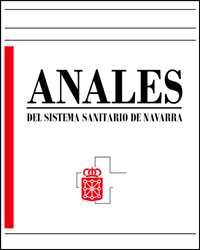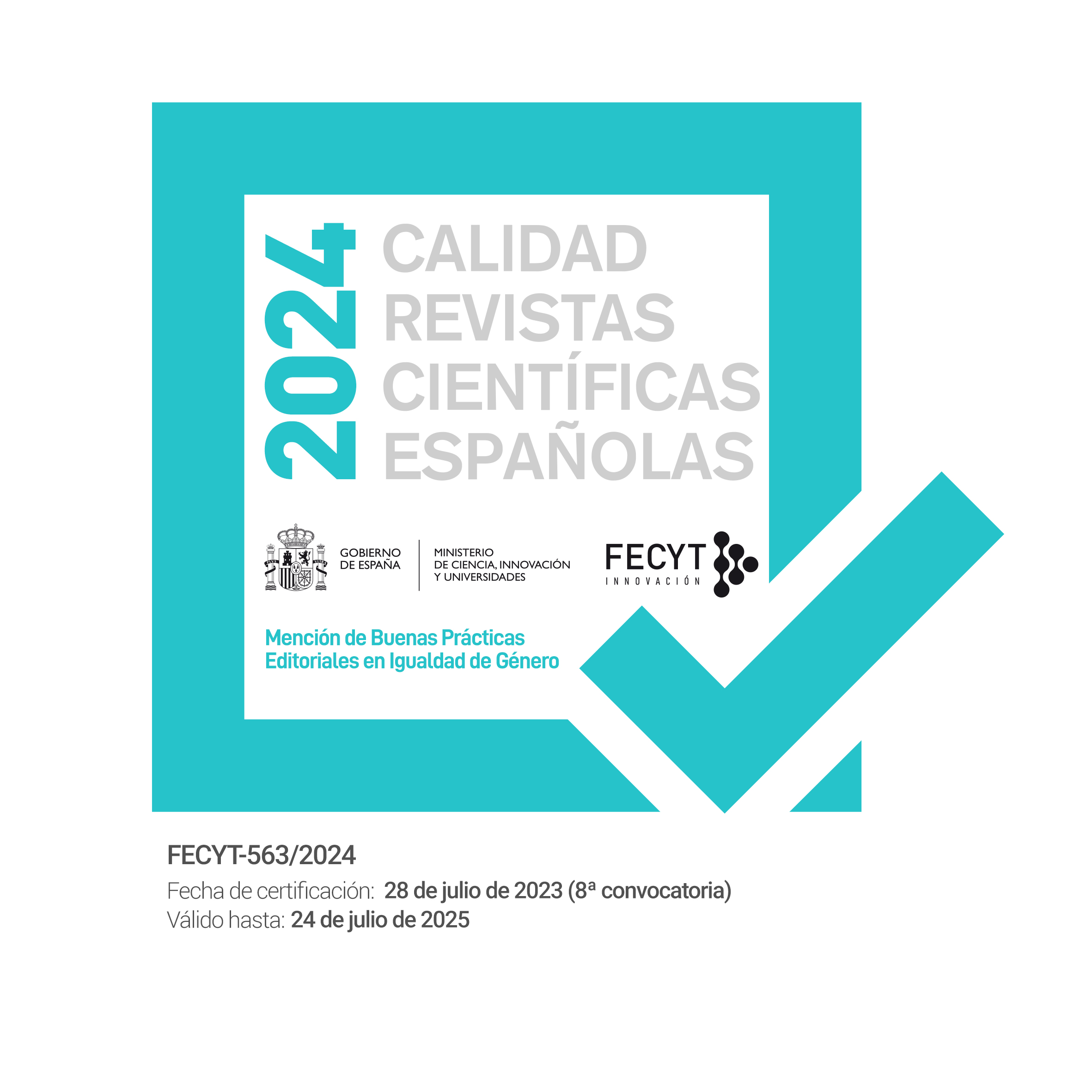Prevalence of diabesity in the Spanish working population: influence of sociodemographic variables and tobacco consumption
DOI:
https://doi.org/10.23938/ASSN.0977Keywords:
Diabesity, Obesity, Diabetes mellitus, Cardiovascular disease, PrevalenceAbstract
Background. Obesity predisposes to type 2 diabetes so often that the combination is called diabesity. The aim of this study was to determine the prevalence of diabesity in the working population and to analyze the variables associated with it.
Method. Cross-sectional study between January 2019 and June 2020 by 418,343 workers from 18 to 67 year-old, from different professions and Spanish geographic areas. The prevalence of diabesity was determined with six different formulae for obesity: BMI (body mass index), CUN BAE (Clínica Universidad de Navarra Body Adiposity Estimator), ECORE-BF (Equation Córdoba for Estimation of Body Fat), Formula Palafolls, FMI (fat mass index) of Deuremberg and RFM (relative fat mass). The association between diabetes and age, sex, social class and tobacco was analyzed.
Results. The global prevalence of diabetes ranged from 2.6% for BMI to 5.8% for the Palafolls formula. The variable most related to diabesity was age over 50 years (OR = 5.9; 95%CI: 5.7-6.2 for BMI, and OR = 8.1; 95%CI: 7.9-8.4 for FMI of Deuremberg). Male sex and social class III related with diabesity estimated by all formulas, while being a smoker was only related with the Palafolls formula.
Conclusion. Diabesity prevalence varies depending on the formula used, with much lower prevalence among women and increased with age independent of the formula used. Its prevalence is higher in the lower social classes.
Downloads
References
LÓPEZ-GONZÁLEZ AA. Globesity: The modern epidemic that is fast becoming the biggest danger to world health. EC Endocrinology and Metabolic Research 2017; 1: 56-57.
FORGA L, PETRINA E, BARBERÍA JJ. Complicaciones de la obesidad. An Sist Sanit Navar 2009; 25 (Suppl 1): 117-126. https://doi.org/10.23938/ASSN.0820
PICHÉ ME, TCHERNOF A, DESPRÉS JP. Obesity phenotypes, diabetes, and cardiovascular diseases. Circ Res 2020; 126: 1477-1500. https://doi.org/10.1161/circresaha.120.316101
BARBANY M, FOZ M. Obesidad: concepto, clasificación y diagnóstico. An Sist Sanit Navar 2009; 25 (Suppl 1): 7-16. https://doi.org/ 10.23938/ASSN.0810
OKORODUDU D, JUMEAN M, MONTORI V, ROMERO-CORRAL A, SOMERS V, ERWIN P et al. Rendimiento diagnóstico del índice de masa corporal para identificar la obesidad definida por la adiposidad corporal: una revisión sistemática y un metanálisis. Int J Obes 2010; 34: 791-799. https://doi.org/10.1038/ijo.2010.5
FAEH D, WILLIAM J, TAPPY L, RAVUSSIN E, BOVET P. Prevalence, awareness and control of diabetes in the Seychelles and relationship with excess body weight. BMC Public Health 2007; 19: 163. https://doi.org/10.1186/1471-2458-7-163
RODRIGUEZ A, CATALÁN V, GÓMEZ-AMBROSI J, FRÜHBECK G. Visceral and subcutaneous adiposity: are both potential therapeutic targets for tackling the metabolic síndrome? Curr Pharm Des 2007; 13: 169-175. https://doi.org/10.2174/138161207781039599
OSNISHI H, SAITOH S, TAKAGI S, OHATA J, TAKEUCHI H, ISOBE T et al. Incidence of insulin resistance in obese subjects in a rural Japanese population: the Tanno and Sobetsu study. Diabetes Obes Metab 2005; 7: 83-87. https://doi.org/10.1111/j.1463-1326.2004.00381.x
POTENZA MA, NACCI C, DE SALVIA MA, SAGARRA L, COLLINO M, MONTAGNANI M. Targeting endothelial metaflammation to counteract diabesity cardiovascular risk: Current and perspective therapeutic options. Pharmacol Res 2017; 120: 226-241. https://doi.org/10.1016/j.phrs.2017.04.009
American Diabetes Association. Diagnosis and classification of diabetes mellitus. Diabetes Care 2010; 33 (Suppl 1): S62-S69. https://doi.org/10.2337/dc10-S062
GÓMEZ-AMBROSI J, SILVA C, CATALÁN V, RODRÍGUEZ A, GALOFRÉ JC, ESCALADA J et al. Clinical usefulness of a new equation for estimating body fat. Diabetes Care 2012; 35: 383-388. https://doi.org/10.2337/dc11-1334
MOLINA-LUQUE R, ROMERO-SALDAÑA M, ÁLVAREZ-FERNÁNDEZ C, BENNASAR-VENY M, ÁLVAREZ-LÓPEZ Á, MOLINA-RECIO G. Equation Córdoba: a simplified method for estimation of body fat (ECORE-BF). Int J Environ Res Public Health 2019; 16: 4529. https://doi.org/10.3390/ijerph16224529
MILL-FERREYRA E, CAMENO-CARRILLO V, SAÚL-GORDO H, CAMÍ-LAVADO MC. Estimation of the percentage of body fat based on the body mass index and the abdominal circumference: Palafolls Formula. Semergen 2019; 45: 101-108. https://doi.org/10.1016/j.semerg.2018.04.007
DEURENBERG P, WETSTRATE JA, SEIDELL JC. Body mass index as a measure of body fatness: age- and sex- specific prediction formulas. Br J Nutr 1991; 65: 105-114. https://doi.org/10.1079/bjn19910073
WOOLCOTT OO, BERGMAN RN. Relative fat mass (RFM) as anew estimator of whole-body fat percentage. A cross-sectional study in American adult individuals. Sci Rep 2018; 8: 10980. https://doi.org/10.1038/s41598-018-29362-1
DOMINGO-SALVANY A, BACIGALUPE A, CARRASCO JM, ESPELT A, FERRANDO J, BORRELL C. Propuesta de clase social neoweberiana y neomarxista a partir de la Clasificación Nacional de Ocupaciones 2011. Gac Sanit 2013; 27: 263-272. https://doi.org/10.1016/j.gaceta.2012.12.009
ORIA E, LAFITA J, PETRINA E, ARGÜELLES I. Composición corporal y obesidad. An Sist Sanit Navar 2009; 25 (Suppl 1): 91-102. https://doi.org/ 10.23938/ASSN.0817
RODRÍGUEZ-RODRÍGUEZ E, LÓPEZ-PLAZA B, LÓPEZ-SOBALER A, ORTEGA R. Prevalencia de sobrepeso y obesidad en adultos españoles. Nutr Hosp 2011; 26: 355-363. https://doi.org/10.1590/S0212-16112011000200017
American Diabetes Association. Standards of Medical Care in Diabetes. Diabetes Care 2005; 28 (Suppl 1): s4-s36. https://doi.org/10.2337/diacare.28.suppl_1.S4
TOPLAK H, LEITNER DR, HARREITER J, HOPPICHLER F, WASCHER TC, SCHINDLER K, LUDVIK B. Diabesity - obesity and type 2 diabetes (update 2019). Wien Klin Wochenschr 2019; 131 (Suppl 1): 71-76. https://doi.org/10.1007/s00508-018-1418-9
PRADHAN AD, SKERRETT PJ, MANSON JE. Obesity, diabetes, and coronary risk in women. J Cardiovasc Risk 2002; 9: 323-330. https://doi.org/10.1097/01.hjr.0000044513.34172.83
KOLB H, MARTIN S. Environmental/lifestyle factors in the pathogenesis and prevention of type 2 diabetes. BMC Med 2017; 15: 131. https://doi.org/10.1186/s12916-017-0901-x
PAPPAS G, QUEEN S, HADEN W, FISHER G. The increasing disparity in mortality between socioeconomic groups in United States, 1960 and 1986. N Eng J Med 1993; 329: 103-109. https://doi.org/ 10.1056/NEJM199307083290207
NAVARRO V, BENACH J. Desigualdades sociales en salud en España. Informe de la Comisión Científica de estudios de las desigualdades sociales en Salud en España. Rev Esp Salud Publica 1996; 70: 505-636. https://www.mscbs.gob.es/biblioPublic/publicaciones/recursos_propios/resp/revista_cdrom/VOL70/70_5_505.pdf
ARANCETA-BARTRINA J, PÉREZ-RODRIGO C, ALBERDI-ARESTI G, RAMOS-CARRERA N, LÁZARO-MASEDO S. Prevalencia de obesidad general y obesidad abdominal en la población adulta española (25–64 años) 2014–2015: estudio ENPE. Rev Esp Cardiol 2016; 69: 579-586. https://doi.org/10.1016/j.recesp.2016.02.010
PEARCE C, RYCHETNIK L, WUTZKE S, WILSON A. Obesity prevention and the role of hospital and community-based health services: a scoping review. BMC Health Serv Res 2019; 19: 453. https://doi.org/10.1186/s12913-019-4262-3
PANKOVA A, KRALIKOVA E, ZVOLSKA K, STEPANKOVA L, BLAHA M, OVESNA P et al. Early weight gain after stopping smoking: a predictor of overall large weight gain? A single-site retrospective cohort study. BMJ Open 2018; 8: e023987. https://doi.org/10.1136/bmjopen-2018-023987
NG ACT, DELGADO V, BORLAUG BA, BAX JJ. Diabesity: the combined burden of obesity and diabetes on heart disease and the role of imaging. Nat Rev Cardiol 2021; 18: 291-304. https://doi.org/10.1038/s41569-020-00465-5
Wells JCK. The diabesity epidemic in the light of evolution: insights from the capacity-load model. Diabetologia 2019; 62: 1740-1750. https://doi.org/10.1007/s00125-019-4944-8
Downloads
Published
How to Cite
Issue
Section
License
Copyright (c) 2021 Anales del Sistema Sanitario de Navarra

This work is licensed under a Creative Commons Attribution-ShareAlike 4.0 International License.
La revista Anales del Sistema Sanitario de Navarra es publicada por el Departamento de Salud del Gobierno de Navarra (España), quien conserva los derechos patrimoniales (copyright ) sobre el artículo publicado y favorece y permite la difusión del mismo bajo licencia Creative Commons Reconocimiento-CompartirIgual 4.0 Internacional (CC BY-SA 4.0). Esta licencia permite copiar, usar, difundir, transmitir y exponer públicamente el artículo, siempre que siempre que se cite la autoría y la publicación inicial en Anales del Sistema Sanitario de Navarra, y se distinga la existencia de esta licencia de uso.








